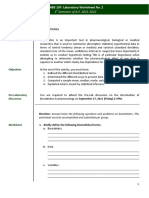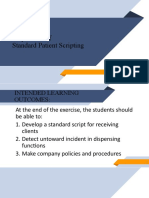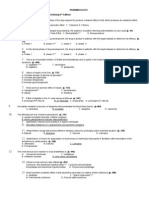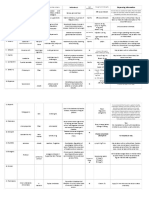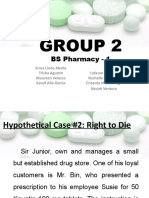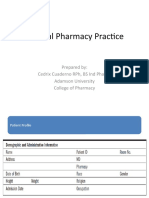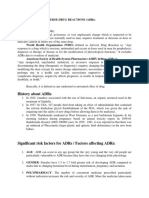Module 3 Pharma Safety and Quality of Drug Administration Final PDF
Module 3 Pharma Safety and Quality of Drug Administration Final PDF
Uploaded by
Michelle HutamaresCopyright:
Available Formats
Module 3 Pharma Safety and Quality of Drug Administration Final PDF
Module 3 Pharma Safety and Quality of Drug Administration Final PDF
Uploaded by
Michelle HutamaresOriginal Title
Copyright
Available Formats
Share this document
Did you find this document useful?
Is this content inappropriate?
Copyright:
Available Formats
Module 3 Pharma Safety and Quality of Drug Administration Final PDF
Module 3 Pharma Safety and Quality of Drug Administration Final PDF
Uploaded by
Michelle HutamaresCopyright:
Available Formats
FAR EASTERN UNIVERSITY
INSTIITUTE OF NURSING
NUR1207 PHARMACOLOGY
MODULE 3: SAFETY AND QUALITY OF DRUG ADMINISTRATION
I. Introduction:
Drug administration should entail quality and safety. This module involves a
discussion of safety initiatives and interventions that include the “five-plus-five”
rights of medication administration, the nurse’s rights when administering
medications, and the Patient Safety Goals. Also, this module will give emphasis on
the nurses need to know about safety risks of handling and disposing medication.
1.1 Goal and Objectives:
This module aims to develop students understanding of the concepts and apply it in
the clinical settings. To achieve this, the students are expected to appropriately
manage their time and critically utilize their learning modalities to be able to:
1. List and understand the importance of “five-plus-five” rights of medication
administration
2. Determine the nurse’s rights when administering medications
3. Critically analyse and document the drug order
4. Apply the safety risks of handling, administering, and disposing medication
1.2 Activities for this module
A. For MIXED ONLINE LEARNING (MOL) – Synchronous + Asynchronous
Learning: Online meeting with faculty for consultation and clarification of
modules + independent learning of content (with options to watch, read or
listen) + online quiz
B. For ASYNCHRONOUS LEARNING: independent learning of content (with
options to watch, read or listen) + online quiz
C. For TOTAL ANALOGUE LEARNING (TAL) : independent learning of
content (with options to watch, read or listen) + critical thinking activity to be
collected in a portfolio
II. Pre-Lecture Activity: Practice Questions
Choose the best answer
1. The nurse is aware that The Joint Commission has recommended which
abbreviation be on the “Do Not Use” list for ordering or documenting
medications?
A. q.o.d C. Subling
B. NPO D. bid
2. The nurse prepares to administer medications. Which are complete drug orders?
(Select all that apply.)
A. Aspirin 81 mg PO daily
B. Multivitamin
C. Vitamin D 2000 units PO
Prepared by: Mayla D. Rivera, MAN, RN, IPC Page 1
D. Ciprofloxacin hydrochloride (Cipro) 500 mg PO q12h × 7d
E. Promethazine 50 mg IV q3-6h PRN for nausea
III. Discussions:
Five-Plus-Five” Rights of Medication Administration
The “five-plus-five” rights of medication administration are important goals for
medication safety.
Five plus Five Rights of medication administration:
1. Right patient 1. Right assessment
2. Right drug 2. Right documentation
3. Right dose 3. Patient’s right to education
4. Right route 4. Right evaluation
5. Right time 5. Right to refuse
Note: The original five rights and the subsequent additions are important safety for
drug administration.
1. Right patient – determining patient identification is an integral part of ensuring
patient safety.
Two important ways of identifying the patient:
A. Ask the patient to state his or her full name and birth date and compare these with the
patient’s identification (ID) band and the medication administration record (MAR).
Many facilities have electronic health records (EHRs) that allow the nurse to directly
scan the bar code from the patient’s ID band. Once the band is scanned, the nurse can
see the patient’s medication record.
B. If the patient is an adult with a cognitive disorder or a child, verify the patient’s name
with a family member. In the event a family member is unavailable, and the patient is
unable to identify self, follow the facility’s policy. Many facilities have policies that
include a photo ID on the band with the patient’s name and birth date affixed to the
band.
Example of a barcode reader used to scan the patient wrist band.
2. Right Drug - The nurse must accurately determine the right drug prior to
administration. Medication order must only be given by those disciplines with
prescriptive authority such as the medical doctor (MD), dentist (doctor of dental
surgery [DDS]), podiatrist (doctor of podiatric medicine [DPM]), certified nurse
practitioner (CNP), advanced practice registered nurse (APRN), physician assistant
Prepared by: Mayla D. Rivera, MAN, RN, IPC Page 2
(PA), veterinarian, chiropractor, and optometrist. In addition, medical clinical
psychiatrists and pharmacists have prescriptive authority with strict guidelines set by
the state.
o Prescriptions may be done by handwritten, telephone order (T/O) or verbal
order (V/O), or directly entered the patient’s EHR. Handwritten prescriptions
are written on a provider’s legal prescription pad and are filled by a
pharmacist.
o All telephone orders or verbal orders for medications are either handwritten by
the nurse taking the order or entered directly into a computer and “read back”
to ensure accuracy and affixing his/her signature. If controlled drugs, 2 nurses
are required to listen and affix their signature.
o After dictating a verbal order, the provider must sign it within 24 hours.
Note: Nursing students are not allowed to accept or take provider orders.
The components of a drug order are as follows:
A. Patient name and birth date
B. Date the order is written
C. Provider signature or name if an electronic order, T/O, or V/O
D. Signature of licensed staff who took the T/O or V/O, if applicable
E. HCPs who wish to prescribe controlled drugs must register with the Drug
enforcement agency (DEA). When prescribing controlled substances, the
HCP’s DEA number must be on the prescription.
F. Drug name and strength
G. Drug frequency or dose (e.g., once daily)
H. Route of administration
I. Duration of administration (e.g., × 7 days, × 3 doses, when applicable)
J. Number of pills to be dispensed
K. Any special instructions for withholding or adjusting dosage based on nursing
assessment, drug effectiveness, or laboratory results
Example of Drug order:
Note:
It is the nurse’s responsibility to administer the drug ordered by the provider. If the
drug order is incomplete, the drug should not be administered. Verification must be
done by the nurses in a timely and respected manner.
Prepared by: Mayla D. Rivera, MAN, RN, IPC Page 3
Nurses are legally liable if they give a prescribed drug and the dosage is incorrect, or
if the drug is contraindicated for the patient’s health status. Once the drug has been
administered, the nurse becomes liable for the predicted effects of that drug
To avoid drug errors, the drug label should be read three times:
1. When you pick up the medication and remove it from the drug cabinet
2. As you prepare the drug for administration
3. When you administer the drug
3. Right Dose - The right dose refers to verification by the nurse that the dose administered is
the amount ordered and that it is safe for the patient for whom it is prescribed. Also, the right
dose is based on the patient’s physical status including the patient’s weight to determine the
right dose.
Note:
Always recheck the drug calculation if the dose is within a fraction or if it is an
extremely large dose. Consult another nurse or the pharmacist when in doubt.
Note the method of dispensing the drug. It could be thru automated dispensing
cabinets (computerized drug storage cabinet), or thru the Unit dose method (single
dose [has reduced dosage errors because no calculations are required]) or thru a
Multidose vial method which required calculations to withdraw an exact amount of
drug according to the dose required.
o If something left in the multidose vial, it should be properly disposed
according the sanitation or hospital policy.
4. Right Time - refers to the time the prescribed dose is ordered to be administered. To
maintain therapeutic level of the drug in the blood plasma level, a daily prescribed order
should have specified intervals. It could be:
1. Once a day
2. twice a day (bid) or every 12 hours
3. three times a day (tid) or every 8 hours
4. four times a day (qid), or every 6 hours (every 6hrs)
Note: Use of military time (24-hour clock) is recommended in the healthcare facility rather
than the standard time because it reduces administration errors.
Types of Drug order:
5. Right Route - The right route is necessary for adequate or appropriate absorption. It is
ordered by the health care provider and indicates the mechanism by which the medication
Prepared by: Mayla D. Rivera, MAN, RN, IPC Page 4
enters the body. It composes of: Oral, sublingual, buccal, transdermal, topical, instillation,
inhalation, nasogastric and gastrostomy tubes, suppositories, and parenteral.
6. Right Assessment - requires the collection of appropriate baseline data before
administration of a drug (e.g., taking a complete set of vital signs and checking lab levels
prior to drug administration).
It is important for the nurse to identify high-risk patients (e.g., patients with
medication allergies, patients on dialysis, those with liver disease, diabetic patients,
cardiac and pulmonary patients, and the elderly and pediatric populations). If at-risk
patients are identified, precautions must be taken to reduce risk.
7. Right Documentation - requires the nurse to record immediately the appropriate
information about the drug administered.
Method of documenting drug administration:
o Paper medication administration record (MAR) - is the commonly used
method specially in the Philippines as per observation
o Computerized charting - nurse enters a personal identification and password
to get access into the system. The computerized system interfaces with other
departments, including the pharmacy, laboratory, and sometimes the
physician’s office.
Note: it is important that nurses must remember that drugs should be signed off
immediately after the drug is administered. A drug that is given but not documented is
considered not given and a drug that is not given but documented is considered given. To
prevent ethico- moral cases, always follow the appropriate documentation process.
Prepared by: Mayla D. Rivera, MAN, RN, IPC Page 5
Sample documentation method
8. Right to Education - The nurse should accurately and thoroughly inform the patient about
the drugs they are taking and how each drug relates to their condition. Teaching the patient
also includes why the patient is taking the drug, what is the expected result of the drug, it
possible good /therapeutic effects, side effects and adverse effects, and if there are any dietary
restrictions or requirements. Patients also has the right to know the laboratory test result
Prepared by: Mayla D. Rivera, MAN, RN, IPC Page 6
monitoring and the necessary skills of drug administration he/she should with return
demonstration before discharge. This is to facilitate continuity of care at home upon
discharge. Informing the patients and families are also integral aspects of preventing
medication errors.
9. Right Evaluation - determines the effectiveness of the drug based on the patient’s
response to the drug. The nurse should ask the patient whether the medication improve the
present health condition. Also, the nurse should evaluate the therapeutic effect of the
medication by assessing the patient response to the drug. Evaluation is an ongoing and is an
important aspect of patient safety.
10. Right to Refuse - patient has the right to refuse the medication, and it is the nurse’s
responsibility to determine the reason for the refusal, explain to the patient the risks involved
with refusal, and reinforce the important benefits of and reasons for taking the medication.
When a medication is refused, the refusal must be documented immediately, and follow-up is
always required. The primary nurse and health care provider should be informed because the
omission may pose a specific threat to the patient (e.g., a change in the lab values with insulin
and warfarin).
Nurses’ Rights when Administering Medication - These rights provide an additional layer
of safety by ensuring that the nurse has what is needed to provide safe medication
administration.
Nurses six rights of administering medication:
1. the right to a complete and clear order (e.g., nurses may clarify a HCP order
that is not clear because it is not legibly written or a verbal or telephone order
that are sounds like or sounds alike.
2. the right to have the correct drug, route (form), and dose dispensed
3. the right to have access to information
4. the right to have policies to guide safe medication administration
5. the right to administer medications safely and to identify problems in the
system
6. the right to stop, think, and be vigilant when administering medication
The Joint Commission National Patient Safety Goals (TJC)
Two important goals that have already become standards for all TJC
1. “Do not use” abbreviations - orders that should be written to avoid
misinterpretation
Prepared by: Mayla D. Rivera, MAN, RN, IPC Page 7
2. List of acceptable abbreviations - are abbreviations that are frequently used in drug
therapy and must be known by the nurse
Prepared by: Mayla D. Rivera, MAN, RN, IPC Page 8
Disposal of Medication – appropriate disposals of used drugs are important to decrease
the amount of controlled substances released into the environment, especially into water
and sewage system.
Facilities may contract with an independent or local collection program authorized by
the state and the FDA/DEA to dispose medical waste and hazardous materials
Hospital should orient the healthcare team including nurses of the convenient, and
responsible methods for collecting and destroying medications and controlled
substances
The drugs are disposed of in a receptacle that must comply with strict security and
record-keeping requirements as established by the FDA/DEA.
Sharps Safety / Needle-stick Injury- Nurses should not risk their lives every time they
use a sharp object or needle. Sharps safety prevent incidents of blood-borne related
disease such as the HIV/AIDS or Hepatitis B. The Occupational Safety and Health
Administration (OSHA) Needle-stick Safety and Prevention Act (NSPA) of 2000 resulted
from the American Nurses Association (ANA) campaign Safe Needles Save Lives.
The NSPA requires that employers implement safer medical devices for their
employees, provide a safe and secure workplace environment with educational
opportunities, and develop written policies to help prevent sharps or needle-stick
injuries. This will include a flowchart of pre-post exposure management.
Use puncture-proof containers to dispose of sharps and needles. Containers must be
closed, puncture resistant, leak proof, color coded, and emptied routinely to prevent
overfilling
Prevention of needle-stick injury in the clinical settings
Safety Risks with Medication Administration - risk to safety includes the following:
1. Tablet splitting. To counteract steeply rising drug costs, some patients are cutting
their pills in half. However, this is not recommended by the FDA. The only time
tablet splitting is advisable is when it is specified by the pharmacist on the label
2. Buying drugs over the Internet. Consumers may find it convenient to order drugs
over the Internet, but precautions must be taken because drugs sold online may be too
old, too strong, or too weak to be effective and are unsafe to use with other
medications
Prepared by: Mayla D. Rivera, MAN, RN, IPC Page 9
3. Dosage Forms: To Crush or Not to Crush - Do not crush any extended- or
sustained-release drugs because this will change the pharmacokinetic phase of the
drug. Although some drugs can be used crushed, some should not be crushed. Always
consult with the pharmacist or, when possible, the health care provider prior to
crushing a patient’s drug.
4. High-Alert Medications - High-alert drugs can cause significant harm to the patient.
If a high-alert medication is given in error, it can have a major effect on the patient’s
organs. This includes cardiac, respiratory, vascular, and neurologic systems.
Examples of high alert drugs:
1. epinephrine
2. Insulin (all forms)
3. magnesium sulfate injection
4. opium tincture
5. potassium chloride concentrates for injection
6. promethazine IV
7. vasopressin, IV or IO.
Lists to reduce risk of errors in administering high alert medication:
1. Simplify the storage, preparation, and administration of high-alert drugs
2. Write policies concerning safe administration
3. Improve information and education
4. Limit access to high-alert medications
5. Use labels and automated alerts
6. Use redundancies (automated or independent double-checks)
7. Closely monitor the patient’s response to the medication (possibly the most
important step)
Look-Alike and Sound-Alike Drug Names - Nurses should be aware and give emphasis
that certain drug names sound alike and are spelled similarly is prone to medication error
and should not be practiced in the clinical settings. Example: Amaryl (glimepiride) with
Reminyl (galantamine). To prevent this incident, nurses should always practice the five
plus five Rights of medication administration.
God Bless and Happy Learning…
Prepared by: Mayla D. Rivera, MAN, RN, IPC Page 10
You might also like
- Psap FinalsDocument127 pagesPsap FinalsLawrence RazonNo ratings yet
- Case 2Document4 pagesCase 2Patrícia Martins25% (4)
- Drug InfomationDocument19 pagesDrug InfomationKeith OmwoyoNo ratings yet
- Fast Facts: Medication Adherence: A Practical Approach to Optimizing Medication UseFrom EverandFast Facts: Medication Adherence: A Practical Approach to Optimizing Medication UseNo ratings yet
- Acute Kidney InjuryDocument4 pagesAcute Kidney Injuryjumi jumdailNo ratings yet
- Pharmaceutical Care Plan - Sample Version: (Dispensing and Medication Safety)Document4 pagesPharmaceutical Care Plan - Sample Version: (Dispensing and Medication Safety)Angela Pabico RosarioNo ratings yet
- Experiment 8 Size Reduction and Particle Size Measurement by Screen Analysis PDFDocument29 pagesExperiment 8 Size Reduction and Particle Size Measurement by Screen Analysis PDFMichelle Hutamares100% (2)
- Drug AdministrationDocument30 pagesDrug AdministrationandreabreeNo ratings yet
- Phamacology Set 2: Page 1 of 24Document24 pagesPhamacology Set 2: Page 1 of 24Jonille EchevarriaNo ratings yet
- Stroke and HypertensionDocument4 pagesStroke and HypertensionKhessie Laye Garcia JacintoNo ratings yet
- Drug Therapy Problems and Quality of Life in Patients With Chronic Kidney DiseaseDocument62 pagesDrug Therapy Problems and Quality of Life in Patients With Chronic Kidney DiseaseAliff Dhurani ZakiNo ratings yet
- REFRESHER QUESTIONS For JurisprudenceDocument3 pagesREFRESHER QUESTIONS For JurisprudenceEnzo TimbolNo ratings yet
- Republic Act No. 8203. Implementing Rules & RegulationsDocument13 pagesRepublic Act No. 8203. Implementing Rules & RegulationsBlue CalizarNo ratings yet
- AsdfgjkDocument14 pagesAsdfgjkMaria Frances Antoniette PerezNo ratings yet
- Soft Skills For Pharmacist 1Document7 pagesSoft Skills For Pharmacist 1shailendra patilNo ratings yet
- Pcol Lab Activity 2 3ADocument6 pagesPcol Lab Activity 2 3AMeryl Ann Ibarra-InganNo ratings yet
- Pharm 231: Hospital Pharmacy: Basic Functions of A HospitalDocument5 pagesPharm 231: Hospital Pharmacy: Basic Functions of A HospitalTESORO Zeus DavidNo ratings yet
- HOSPITAL AND CLINICAL PHARMACY - PACOP VioletDocument27 pagesHOSPITAL AND CLINICAL PHARMACY - PACOP VioletExequiel BoriborNo ratings yet
- Lec (2) Medication Therapy Management PDFDocument21 pagesLec (2) Medication Therapy Management PDFIbraheem AliNo ratings yet
- Code of Ethics For PharmacistDocument1 pageCode of Ethics For PharmacistSunshine BaclaanNo ratings yet
- 29880020: Antiepileptic Drugs in Critically Ill PatientsDocument12 pages29880020: Antiepileptic Drugs in Critically Ill PatientsEward Rod SalNo ratings yet
- The Antibiotic Self-Medication Practices of Residents of Iloilo CityDocument17 pagesThe Antibiotic Self-Medication Practices of Residents of Iloilo CityLALANo ratings yet
- Pharmacology Practice Questions 2010Document4 pagesPharmacology Practice Questions 2010Khairul IzzatNo ratings yet
- Final Hospital Pharmacy Module 2Document6 pagesFinal Hospital Pharmacy Module 2Meryl Ann Ibarra-InganNo ratings yet
- M2 - Lesson 1 - Preparation of Standard Patient ScriptingDocument22 pagesM2 - Lesson 1 - Preparation of Standard Patient ScriptingElleason Joshua G. FranciscoNo ratings yet
- Case Study - Parkinson'S Disease: Clinical Pharmacy & Therapeutics 1Document13 pagesCase Study - Parkinson'S Disease: Clinical Pharmacy & Therapeutics 1Jenesis Cairo CuaresmaNo ratings yet
- Pharmacology Board ReviewDocument599 pagesPharmacology Board ReviewMelbhon Fabro RamosNo ratings yet
- Beyond Use DateDocument56 pagesBeyond Use DateDa Chan100% (1)
- Lecture-9 Therapeutics Planning: Pharmacy Practice ExperienceDocument19 pagesLecture-9 Therapeutics Planning: Pharmacy Practice ExperienceLayla100% (1)
- Adverse Drug ReactionDocument6 pagesAdverse Drug ReactionNunkoo RajNo ratings yet
- Introduction To Evidence-Based MedicineDocument28 pagesIntroduction To Evidence-Based Medicinedila2706No ratings yet
- M. Pharm Review NAPLEX38Document1 pageM. Pharm Review NAPLEX38JUSASBNo ratings yet
- DispensingDocument12 pagesDispensingKitkat CasacopNo ratings yet
- Epidemiology and Its ControlDocument124 pagesEpidemiology and Its ControlEman ZiaNo ratings yet
- Literature Review 3.1 Introduction To PrescriptionDocument69 pagesLiterature Review 3.1 Introduction To PrescriptionAnsh MishraNo ratings yet
- Clinical Pharmacy Lab - Quiz Part 2Document4 pagesClinical Pharmacy Lab - Quiz Part 2Aassh DcmbrNo ratings yet
- Naveen Kumar.M M.Pharmacy (Pharmaceutics) - 10Y81SO310Document29 pagesNaveen Kumar.M M.Pharmacy (Pharmaceutics) - 10Y81SO310Benish RasheedNo ratings yet
- Pharma La La La LaDocument32 pagesPharma La La La LaAndie AlbinoNo ratings yet
- Chapter 9.odtDocument31 pagesChapter 9.odtsteamierNo ratings yet
- Intern Drug ListDocument5 pagesIntern Drug ListKenette Diane CantubaNo ratings yet
- BiotransformationDocument27 pagesBiotransformationDemy Clemente100% (1)
- Code of Ethics For PharmacistsDocument3 pagesCode of Ethics For PharmacistsAmina Abba HaliruNo ratings yet
- TheracomDocument11 pagesTheracomIk-ik Miral100% (1)
- Case StudyDocument9 pagesCase StudyJayr MartinNo ratings yet
- Def of Forensic Pharmacy by FatimaDocument7 pagesDef of Forensic Pharmacy by FatimaTofeeque Ali GhouriNo ratings yet
- Group 2: BS Pharmacy - 1Document16 pagesGroup 2: BS Pharmacy - 1Keziah VenturaNo ratings yet
- Pharmacology & Parenteral TherapiesDocument44 pagesPharmacology & Parenteral Therapiesjennylyn guadalupeNo ratings yet
- Clinical Pharmacy Practice: Prepared By: Cedrix Cuaderno RPH, Bs Ind Pharm. Adamson University College of PharmacyDocument30 pagesClinical Pharmacy Practice: Prepared By: Cedrix Cuaderno RPH, Bs Ind Pharm. Adamson University College of PharmacyCedrix CuadernoNo ratings yet
- Drug Use EvaluationDocument27 pagesDrug Use Evaluationshanthi dasariNo ratings yet
- MCQ On SchizophreniaDocument10 pagesMCQ On SchizophreniaGolda Meboya0% (1)
- Toxicology MCQs LJDocument14 pagesToxicology MCQs LJrozina mulatNo ratings yet
- Name Honor Pledge (Signature) : Questions 1 - 2 Refer To The Following CaseDocument9 pagesName Honor Pledge (Signature) : Questions 1 - 2 Refer To The Following CasegregstevensNo ratings yet
- Drug Development EssayDocument5 pagesDrug Development EssayDoyin AwodeleNo ratings yet
- Introduction To PharmacologyDocument2 pagesIntroduction To PharmacologyJoy Ann Akia PasigonNo ratings yet
- ADR Final1Document10 pagesADR Final1Rubina BisankheNo ratings yet
- Contraception Questions and Answers For PharmacistsDocument9 pagesContraception Questions and Answers For PharmacistsMohamed OmerNo ratings yet
- Orca Share Media1676520747452 7031837677123776726Document323 pagesOrca Share Media1676520747452 7031837677123776726jasterserognasNo ratings yet
- Green PacopDocument12 pagesGreen PacopsenandshanNo ratings yet
- Antipsychotics 1Document41 pagesAntipsychotics 1fahad rustam100% (1)
- Pharmaceutical CareDocument27 pagesPharmaceutical Caremai elewaNo ratings yet
- The politics of hunger: Protest, poverty and policy in England, <i>c.</i> 1750–<i>c.</i> 1840From EverandThe politics of hunger: Protest, poverty and policy in England, <i>c.</i> 1750–<i>c.</i> 1840No ratings yet
- Results and Discussion: Table 1. Diffusivities at 50 CDocument7 pagesResults and Discussion: Table 1. Diffusivities at 50 CMichelle HutamaresNo ratings yet
- Module 5 Computation of IV Fuid Final PDFDocument25 pagesModule 5 Computation of IV Fuid Final PDFMichelle Hutamares100% (1)
- AIR MLSS 1.490 MG/L Q 128 M /day Influent Effluent: AeratorDocument4 pagesAIR MLSS 1.490 MG/L Q 128 M /day Influent Effluent: AeratorMichelle HutamaresNo ratings yet
- Music Produces A Kind of Pleasure Which Human Nature Cannot Do WithoutDocument2 pagesMusic Produces A Kind of Pleasure Which Human Nature Cannot Do WithoutMichelle HutamaresNo ratings yet
- Skills - Care of The Pregnant Patient ComputationsDocument5 pagesSkills - Care of The Pregnant Patient ComputationsMichelle HutamaresNo ratings yet
- Module 1 Basics of Pharmacology PDFDocument21 pagesModule 1 Basics of Pharmacology PDFMichelle HutamaresNo ratings yet
- Red OxDocument5 pagesRed OxMichelle HutamaresNo ratings yet
- ACTIVITY NO - 6 - Parasitology - Parasitic HelminthesDocument8 pagesACTIVITY NO - 6 - Parasitology - Parasitic HelminthesMichelle HutamaresNo ratings yet
- Far Eastern UniversityDocument14 pagesFar Eastern UniversityMichelle HutamaresNo ratings yet
- Requirement For Fieldtrips and Seminars: Chemical Engineering DepartmentDocument9 pagesRequirement For Fieldtrips and Seminars: Chemical Engineering DepartmentMichelle HutamaresNo ratings yet
- Sample Problems of Chromium Hexa and CyanideDocument3 pagesSample Problems of Chromium Hexa and CyanideMichelle HutamaresNo ratings yet
- Cyanobacteria: Figure 1. Microscopic Illustration of CyanobacteriaDocument7 pagesCyanobacteria: Figure 1. Microscopic Illustration of CyanobacteriaMichelle HutamaresNo ratings yet
- Covid ControlDocument1 pageCovid ControlMichelle HutamaresNo ratings yet
- Patient Info Nursing Problem(s) Rank Justification (Rationale)Document4 pagesPatient Info Nursing Problem(s) Rank Justification (Rationale)Michelle HutamaresNo ratings yet
- Module 1 - Art - CaringDocument65 pagesModule 1 - Art - CaringMichelle Hutamares100% (1)
- Death and Dying: Presented by Dr. Judith SugayDocument21 pagesDeath and Dying: Presented by Dr. Judith SugayMichelle HutamaresNo ratings yet
- Sample Problem and SolutionDocument3 pagesSample Problem and SolutionMichelle HutamaresNo ratings yet
- Wrapping or PackagingDocument5 pagesWrapping or PackagingMichelle HutamaresNo ratings yet















